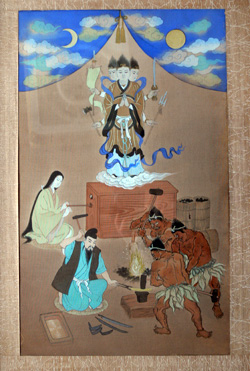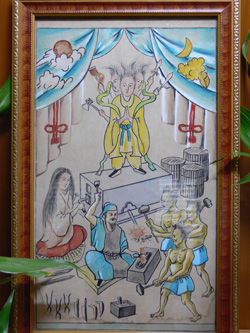
Date of the research: January 23-24, 2010
We undertook a fieldwork project on January 23, 2010 in Nakijin, and on January 24 in the south-central part in Okinawa. The former was led by Nakahara Hirotetsu, the director of the Nakijin Culture Centre. The latter was led by Ōshiro Seiei.
On the 23rd we undertook our survey at the Uema residence (上間殿内) and at the Kinman residence (金満殿内) both in Nakijin Village.
On 24th an image of the blacksmith deity (鍛冶神図) was examined at the residence of Tōyama Yoshinori in Misato, Okinawa City. The iconography of Tongtingku (土帝君 – see the page on Tongtingku ) was investigated at the Shiroma family residence in Tsuhako, Sashiki Town. An image of the blacksmith deity was also examined at the Chinen residence in Torihori, Shuri.
Here, however our purpose is simply to report on the blacksmith images in the custody of the Tōyama and Chinen households.
A) The premises of Tōyama Yoshinori.
The Tōyamas were a family belonging to the Shuri shizoku (a samurai family), though their original family name is unknown. The first-known head of the family was Tōyama chikudun-pēchin (當山筑登之親雲上). In the Meiji period, he might have been a blacksmith.
That business was pursued within the family up to the generation of Tōyama Yoshinori’s grandfather. After the Second World War, that grandfather moved from Misato to Noborikawa in the Okinawa City area. And he then functioned as a blacksmith in Horikawa, Tamagusuku. Finally, he returned to Okinawa City. Coincidentally, his grandmother was from a family of blacksmiths, the Isas in Awase (now Okinawa City), too.
When the grandfather came back after the Battle of Okinawa, there was no image of any blacksmith deity. American forces might have removed it and smuggled it out, it having been one of the biggest residences in the village. After a while, that residence was burned down and with it the formal family tree.
A new image was painted by Yanagi Kōkan (柳光観) , with an inscription carrying the date of its creation on the back of the frame, ‘On a propitious day in October 1959’. At the relative’s house in Misato, there is a similar picture also by Yanagi Kōkan. Its condition, however, is not good.

Painter: Yanagi Kōkan (Japanese-style painter)
Date of creation: a propitious day in October (lunar calendar) 1959.
Size: the external dimensions; 62.0×39.1(length×width/centimeters)
The internal dimensions: 42.2×25.4
Inscription: 一九五九年旧十月吉日揮毫首里汀良区二班日本画家 柳光観揮寫風器神
Materials and technique: polychrome on silk
Format: framed
Place: In the room containing a butsudan, i.e., a Buddhist household altar, there is a small shrine (zushi) on the right. The picture stands between flower vases on the upper section of the altar. In the middle section there is a glass standing between water jugs. At its base there is an incense burner.
Condition: good
Name: Fūchi-nu-kan
The details of the picture: After the Battle of Okinawa, Tōyama Yoshinori’s father commissioned Yanagi Kōkan to paint it. Yanagi might have seen other examples.
Motifs: curtains, clouds, the moon, the sun, the blacksmith deity, a woman, a man, straw charcoal bags, a pair of bellows and a water jug.
Composition: In the upper part is a blue curtain on which are painted clouds of white or blue-green. The sun and the moon are on the right and left, respectively. In the middle is painted the blacksmith deity. He takes the form of a figure with three faces and six arms; he is placing his palms together in prayer while the four other hands are holding a spear with a flag affixed, an axe, a sword and a pike. He stands on a cloud which is positioned on a pair of bellows. On the left sits a young woman. On the right, there are straw charcoal bags, one of which is lying flat. At the lowest level, there are three muscular demons (oni) wearing headbands; the one furthest back is raising a hammer over his head, the middle one is swinging another hammer down, and the third is assuming a posture in the foreground. Besides those, there are a bearded man acting as a master (yokoza 横座), two tempered swords, three sickles and a water jug.
Custom (the mode of making offerings): Fūchi-nu-Yūē, the Festival of the bellows was held on November 7 by the lunar calendar. Prepared offerings includes such items as chiragā (面皮 – the mask of a slaughtered pig), or a whole chicken which often stands with out-stretched wings and with a leaf in its beak. Nowadays, they offer a joint of bacon and a chicken.
The grandfather used to invite neighbours to the smithy. The offering of contributions started at noon on the 7th and continued to the 8th. For a few days, they prayed for their success, adopting postures of gratitude.
Family: the first-generation founder had been a member of the Shuri shizoku. The present head of the family, Tōyama Yoshinori, represents the sixth generation. The smithy business continued to the fifth generation. Even while his grandfather was still alive, the production of farm tools had become a rare activity. He explained that the first generation would have been appointed by the Shuri government for the purposes of keeping an eye on the peasants lest they revolted.
We suppose that Yanagi Kōkan knew of Marishiten (摩利子天) images. Marishiten had appeared as the goddess of mirages. After the Middle Ages, she was changed to the god of battle. The portrayal was of a man riding on a wild boar with weapons. It is similar to the style of the Sanpō-kōjin (三宝荒神) who has three faces and six arms. There is, in Hiroshima, for example, an image of Sanpō-kōjin painted as the blacksmith deity riding on a wild boar. Yanagi Kōkan inscribed the word Marishiten, thus indicating that he might have known of other images of her.
B) The residence of Chinen Gensei in Torihori, Shuri. (He represents the main Chinen family of Goya, now in Okinawa City, and the Chinen family of Shinkai, Sashiki Town.
We visited Chinen Gensei, and inspected the image of the blacksmith deity and the Emperor Guan (Kantei). In the room containing the Buddhist altar, there were an incense burner on the left side, the butsudan itself with the blacksmith iconography in the centre, and the Emperor Guan on the right side. There were five incense burners on the butsudan.
The Chinen family comes from the line of blacksmiths who had worked in Shuri Castle. One of the kings gave Chinen some premises in Torihori called Mī-bashi Ufukanjā. They are said to have discovered clamps when a descendant undertook building improvements on the site of the residence. The family business ceased during the time of Chinen Gensei’s grandfather. Furthermore, the Chinen family recounts the story that their family line was descended from King Satto (察渡王). Before the Battle of Okinawa, there used to be a hanging scroll depicting the blacksmith deity.

Painter: the cousin of Chinen Gensei,a graduate of the Art Course of the University of the Ryukyus.
Date of commission: about 50-55 years ago. (It was painted when the artist was in his third year of high school.)
Size: unknown (We failed to note it.)
Inscription: unknown (We did not inspect the reverse of the frame)
Material: drawing paper, water colour, a felt-tip pen (?).
Format: framed.
Place: In the Buddhist altar room which is next to the front door, the depiction of the blacksmith deity standing between the ihai on the butsudan.
There is a picture of the Emperor Guan on horseback on a small shrine beside the butsudan. It was bought by Tōyama Yoshinori’s wife from the Teruya shikki-ten (a lacquer ware shop), and a former seated image was painted by a certain Nagamine living in Kinjo, Shuri.
Condition: good
Name: unknown
Motifs: curtain, clouds, moon, sun, the blacksmith deity, a woman wearing a white cloth with a red hakama, a man in a Japanese kimono, three demons wearing blue knee-length shorts, straw charcoal bags, a bellows, pillars and a water jug.
Composition: In the upper part, there is a blue curtain on which are painted clouds of white or green. The sun and the moon are depicted on the right and left, respectively. At the bottom of the blue curtains, there are eight pillars. In the middle is depicted the blacksmith deity which is given the shape of a figure with three faces and six arms. He is placing his palms together in prayer while his other four hands are holding a spear with a flag attached, an axe, a sword and a pike. He stands on a cloud which is placed on some bellows. On the left side sits a young woman. On the right side there are three straw charcoal bags.
There are three demons though a bearded man is presiding over the fire. Beside the bearded man, there are two tempered swords, two sickles, three tongs and an anvil.
The details of the picture: Chinen Gensei’s mother might have commissioned her nephew to paint this picture. He would probably have referred to pictures in the possession of other families. The original disappeared during the Battle of Okinawa.
Custom (the mode of making offerings): Fūchi-nu-Yūē, the Festival of the Bellows was held on November 7 by the lunar calendar.
- Offerings: a whole chicken with out-stretched wings and a leaf in its beak.
- Since Chinen Gensei’s mother passed away, they have offered pork and eggs with rice on a tray during the Bon period.
- They go to worship at Okuma Kanjā every fifth year. (Before the Second World War, that used to occur every three years.)
The line:
- The Chinen blacksmith family originated from Okuma Kanjā and has ba (馬) as its lineage). The family members might be termed descendants of King Satto.
- The formal family tree was burned after Chinen Gensei’s mother had left it with an art teacher.
- The family smithy business ceased during the Meiji era. Chinen Gensei’s father was a professional soldier. After the Battle of Okinawa, he was involved in pig rearing.
- They are said to have discovered clamps or thibiku when their land was developed. Blacksmiths might build their workplaces in the suburbs as a precaution in handling fire. Sometimes, they would separate the house from the workplace. There was a smithy at Shuri Castle where such work continued until about 1872.
- The Chinen family would be of high rank in Shuri, which would explain why the Chinens might have produced the Noro next highest after Kikoe-Ōgimi (聞得大君). And they received permission to erect an arch, roofed with tiles.
- A blacksmith from the Chinen family was sent by the royal government to China as a student to study the craft.
- The Chinen family say that their skills in smithing were acquired from China, on the order of the Kingdom government, and that the Chinens might have been granted a reward, but that disappeared in the Battle of Okinawa.
Conclusion:
We designed our research with the aim of discovering surviving images of the blacksmith deity, undertaking it in the south-central part of the main island of Okinawa. There are many images of that deity painted by Yanagi Kōkan. But we know that Kōkan had no stereotypical image of it since we can see his Marishiten inscription. We should undertake a more extensive study of Kōkan.
There are other similar cases, and similar modes of making offerings. The arrangements at Fūchi-nu-Yūē were shared by other blacksmith lines. To take one example, a camellia leaf was put in the mouth of a pig or beak of a chicken. That would indicate the influence of Taoism. Here again more research is needed.
Ōshiro Seiei in Sashiki is calling for support in the creation of a network to investigate the different smithing family lines. He thinks that a formal record should be established including data on the priesthood and the images of the Blacksmith deity.
copyright (c) 2009 Okinawa Zuzō Kenkyukai All Rights Reserved.

